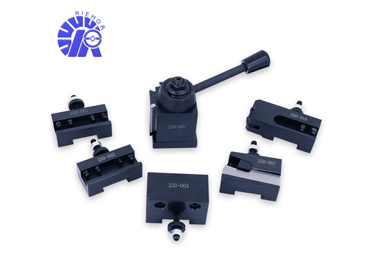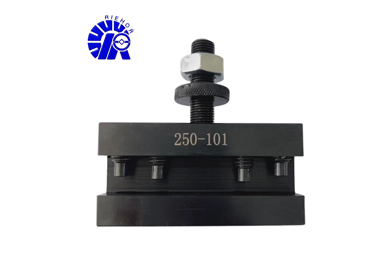How Do I Choose a Quick Change Tool Post?
Choosing a quick change tool post (QCTP) for your lathe is an important decision that can significantly impact your machining efficiency and precision. Here are some factors to consider when selecting the right QCTP for your lathe:
1. Lathe Size and Capacity:
Ensure that the QCTP you choose is compatible with the size and capacity of your lathe. Different lathes have varying swing and distance between centers, so select a QCTP that matches your lathe's specifications.
2. Toolholder Compatibility:
Check if the QCTP is compatible with the types and sizes of toolholders you intend to use. Some QCTPs are designed for specific toolholder series, while others offer more versatility.
3. Toolholder Changeover Time:
One of the primary advantages of a QCTP is the quick and easy tool changeover. Evaluate the speed and ease of changing toolholders with the QCTP you're considering.
4. Precision and Rigidity:
Look for a QCTP that offers high precision and rigidity. This ensures that your tools are securely held and maintain their position during machining, leading to better accuracy and surface finish.
5. Tool Height Adjustment:
Check how the QCTP handles tool height adjustments. Some models have a built-in mechanism for adjusting tool height, while others may require shims or additional components.
6. Toolholder Selection:
Consider the availability of toolholders and accessories for the QCTP. Ensure that you can easily find and purchase toolholders for your specific needs.
Maximize Efficiency with Sanitary SMS Union Solutions
Maximize Efficiency with 63mm Gate Valve Insights
Top Valve Housing Vendors: Choose the Best for Your Needs
Key Questions to Ask When Selecting a Valve Parts Casting Vendor
Unlocking Success: Die Cast Pump Housing Export Insights
7. Durability and Material:
How to Compare Internal Hex Screw Prices in Chile?
Top Trends in High-Quality Lock Stamping Components 2024
Evaluate the durability of the QCTP. It should be made of high-quality materials, such as hardened steel, to withstand the rigors of machining.
8. Price and Budget:
QCTPs come in a range of prices. Set a budget for your purchase and look for options that offer the features you need within your budget constraints.
9. Brand and Reputation:
Research the reputation of the brand and model you're considering. Established and reputable manufacturers often provide better quality and customer support.
10. Mounting and Compatibility:
Ensure that the QCTP can be easily mounted on your lathe's compound rest. Check if any additional adapters or modifications are required for proper installation.
11. Flexibility:
Consider the flexibility of the QCTP system. Some models allow for multiple toolholders to be mounted simultaneously, offering more versatility in your machining operations.
12. User Reviews and Recommendations:
Read user reviews and seek recommendations from experienced machinists or colleagues who have used the same QCTP. Their insights can provide valuable information about ease of use and performance.
13. Warranty and Support:
Check if the QCTP comes with a warranty and if the manufacturer provides customer support in case of issues or questions.
Remember that the choice of a QCTP is a long-term investment that can impact the efficiency and precision of your machining operations. Take your time to research and evaluate different options to select the one that best suits your lathe and machining needs.
Recommended article:Optimizing Phosphating for Lock Stamping Components
Current Prices of Internal Hex Screws in Laos
The Ultimate Guide to Rooftop Parking Air Conditioners
Electronic component feeder an efficient and automated production tool





